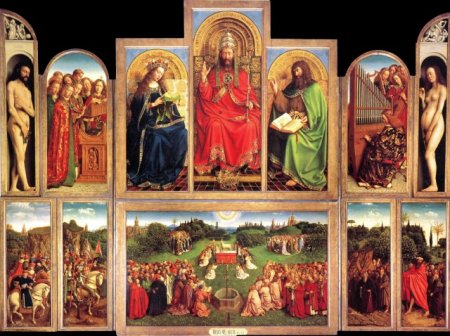 Our readings for today asked us to take a decidedly higher, drier road. They ask us to meditate upon the dangers of the watery image or, more to the point, of the images made by water. In Richard Neer's reading of Poussin, the dying figures of Narcissus and Echo are chastening warnings to the followers of Caravaggio who would simply copy appearances or "aspects" of nature rather than engaging in Poussin's emulative model of classicizing invention from imitation—the active appropriation and recombination of a variety of motifs from learned sources. (Neer, 274; 275; 277-8) That model is figured in and around the god Bacchus who is being reborn in the picture's darkened grotto. So, this God of Wine reborn is the living, vital image of true painting; but, if we expect him to appear optically wet—to render visible those outward trappings of his liquidity—then we are but in thrall to that pernicious, flattening of art into the mechanical replication Poussin saw in prints. (This reading might finally help me to work past my loathing of the arid, ascetic dryness of Poussin's paintings!)
Our readings for today asked us to take a decidedly higher, drier road. They ask us to meditate upon the dangers of the watery image or, more to the point, of the images made by water. In Richard Neer's reading of Poussin, the dying figures of Narcissus and Echo are chastening warnings to the followers of Caravaggio who would simply copy appearances or "aspects" of nature rather than engaging in Poussin's emulative model of classicizing invention from imitation—the active appropriation and recombination of a variety of motifs from learned sources. (Neer, 274; 275; 277-8) That model is figured in and around the god Bacchus who is being reborn in the picture's darkened grotto. So, this God of Wine reborn is the living, vital image of true painting; but, if we expect him to appear optically wet—to render visible those outward trappings of his liquidity—then we are but in thrall to that pernicious, flattening of art into the mechanical replication Poussin saw in prints. (This reading might finally help me to work past my loathing of the arid, ascetic dryness of Poussin's paintings!)Eve too, in John Milton's telling, is confused about which image tradition to follow. Adam's image, made from his flesh and blood, she awakens and espies a bewitching, lovely presence in the "liquid plain" of Paradise's pool. But, unlike Echo to Eve's feminine Narcissus, Adam can actively call her out of her reverie, alerting her that this is but her own reflection she sees. Appealing to something like Poussin's internally-differentiated, imitative tradition of reproduction, Adam encourages Eve to turn away from her own water-reflected image and embrace "he / Whose image thou art, him thou shall enjoy / Inseparably thine, to him thou shall enjoy / Multitudes like thyself, and hence shall be called / Mother of human race." (Milton IV, 471-475) Like Hari in Tarkovsky's Solaris, Eve has been made from Adam by an intelligent agent—God, in the case; not a watery planet. Yet, offered this prodigious, replicative order, she resists. She turns back to the softer, watery image she originally saw in the pool.
This capacity of the pool to transform the luminous world into an image more compelling than itself is given interesting treatment by Bachelard: "It then seems as though contemplated nature helps in the contemplating. ... Is it the lake or the [human] eye which contemplates better? The lake or pool or stagnant water stops us near its bank. It says to our will: you shall go no further; you should go back to looking at distant things, at the beyond. While you were wandering, something here was already looking on. The lake is a large tranquil eye. The lake takes all of light and makes a world out of it." (Bachelard, 28) Clearly, this is treading similar ground to Housekeeping; but, it also makes fascinating address to Poussin who defines painting as " 'an Imitation with lines and colors on any surface of all that is to be found under the sun.'" (Neer, 274) Yet, Poussin represses from his Birth of Bacchus the figure he had planned of the Sun God Apollo. (Neer 278-9) Why?
How might Bachelard's curious comment that "in Bruges, every mirror is stagnant water," help us to understand Lucas de Heere's praise poem whereby the Ghent altar piece is both a mirror and the sea? (Van Mander 62) How does the solar scope of painting for Poussin compare or contrast to the antagonism between the sun and the unctuous image for Muñoz and for Van Eyck? (57) Does the scabby surface of the stained Venetian picture according to Sohm problematize the portrait of liquid generativity painted by Neer? Let me get back to you on that one.

No comments:
Post a Comment